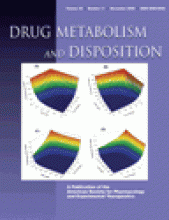Abstract
The human colon carcinoma cell line Caco-2 is often used as a model for intestinal drug absorption. To better understand xenobiotic glucuronidation in Caco-2 cells, we have examined the expression levels of different UDP-glucuronosyltransferases (UGTs) in them. The effects of two main factors were investigated, namely, passage number and cell differentiation. Hence, the mRNA levels of 15 human UGTs of subfamilies 1A and 2B were assessed in both undifferentiated and fully differentiated cells at four passage levels: P31, P37, P43, and P49. Quantitative reverse transcriptase-polymerase chain reaction was used to determine the mRNA levels of individual UGTs, and the values were normalized using β-actin as a reference gene. The results indicate that although passage number in the tested range exerts a mild effect on the expression level of several UGTs, the contribution of cell differentiation is much larger. The expression of nearly all the UGTs that were examined in this study was significantly, sometimes greatly, increased during cell differentiation. UGT1A6 was a distinct exception to this rule, however, because it was already highly expressed in the undifferentiated cells. The mRNA findings were confirmed at the enzyme activity level by measuring the glucuronidation of 1-naphthol, a very good substrate for UGT1A6, as well as estradiol that is not glucuronidated by this enzyme. The results revealed that 1-naphthol glucuronidation activity was high in both the differentiated and undifferentiated cells, whereas estradiol glucuronidation was only detected in the differentiated cells. Thus, Caco-2 cell differentiation plays a major role in UGT expression and ensuing metabolic reactions.
Footnotes
-
This study was financially supported by TEKES (Finnish Funding Agency for Technology, Project No. 40186/04), Orion Pharma, European Union (LIINTOP, LSH-2005-1.2.3-4), and the Academy of Finland (Project No. 210933).
-
doi:10.1124/dmd.108.022335.
-
ABBREVIATIONS: UGT, UDP-glucuronosyltransferase; RT-PCR, reverse transcriptase-polymerase chain reaction; qRT-PCR, quantitative RT-PCR; HPLC, high-performance liquid chromatography; Ct, threshold cycle.
-
↵
 The online version of this article (available at http://dmd.aspetjournals.org) contains supplemental material.
The online version of this article (available at http://dmd.aspetjournals.org) contains supplemental material. - Received May 13, 2008.
- Accepted August 7, 2008.
- The American Society for Pharmacology and Experimental Therapeutics
DMD articles become freely available 12 months after publication, and remain freely available for 5 years.Non-open access articles that fall outside this five year window are available only to institutional subscribers and current ASPET members, or through the article purchase feature at the bottom of the page.
|







